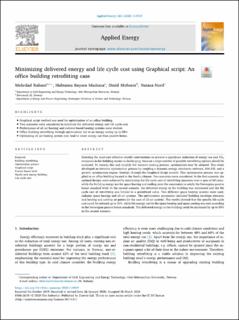| dc.contributor.author | Rabani, Mehrdad | |
| dc.contributor.author | Madessa, Habtamu Bayera | |
| dc.contributor.author | Mohseni, Omid | |
| dc.contributor.author | Nord, Natasa | |
| dc.date.accessioned | 2020-04-24T08:18:10Z | |
| dc.date.available | 2020-04-24T08:18:10Z | |
| dc.date.created | 2020-04-21T09:25:43Z | |
| dc.date.issued | 2020 | |
| dc.identifier.citation | Applied Energy. 2020, 268 . | en_US |
| dc.identifier.issn | 0306-2619 | |
| dc.identifier.uri | https://hdl.handle.net/11250/2652351 | |
| dc.description.abstract | Selecting the most cost-effective retrofit interventions to achieve a significant reduction of energy use and CO2 emissions in the building sectors is challenging, because a large number of possible retrofitting options should be analyzed. To remedy this and simplify the decision-making process, optimization may be adopted. This study developed an iterative optimization process by coupling a dynamic energy simulation software, IDA-ICE, and a generic optimization engine, GenOpt, through the Graphical Script module. This optimization process was applied to an office building located in the Nordic climate. Two scenarios were considered. In the first scenario, the optimal designs were achieved by minimizing the life cycle cost of retrofitting measures over a span of 60 years, while the building energy use for space heating and cooling were the constraints to satisfy the Norwegian passive house standard level. In the second scenario, the delivered energy to the building was minimized and the life cycle cost of retrofitting was limited to a predefined value. Two different space heating systems were used, radiator space heating and all-air systems. The optimization parameters included building envelope elements and heating and cooling set points (in the case of all-air system). The results showed that the specific life cycle cost could be reduced up to 11%, while the energy use for the space heating and space cooling was met according to the Norwegian passive house standards. The delivered energy to the building could be decreased by up to 55% in the second scenario. | en_US |
| dc.language.iso | eng | en_US |
| dc.publisher | Elsevier | en_US |
| dc.rights | Navngivelse 4.0 Internasjonal | * |
| dc.rights.uri | http://creativecommons.org/licenses/by/4.0/deed.no | * |
| dc.title | Minimizing delivered energy and life cycle cost using Graphical script: An office building retrofitting case | en_US |
| dc.type | Peer reviewed | en_US |
| dc.type | Journal article | en_US |
| dc.description.version | publishedVersion | en_US |
| dc.source.pagenumber | 114929 | en_US |
| dc.source.volume | 268 | en_US |
| dc.source.journal | Applied Energy | en_US |
| dc.identifier.doi | 10.1016/j.apenergy.2020.114929 | |
| dc.identifier.cristin | 1807248 | |
| dc.description.localcode | © 2020 The Author(s). Published by Elsevier Ltd. This is an open access article under the CC BY license (http://creativecommons.org/licenses/BY/4.0/). | en_US |
| cristin.ispublished | true | |
| cristin.fulltext | original | |
| cristin.qualitycode | 1 | |

